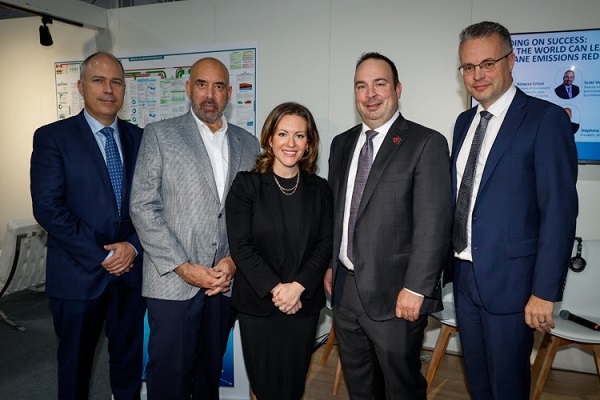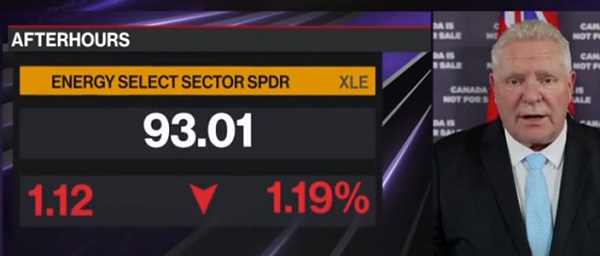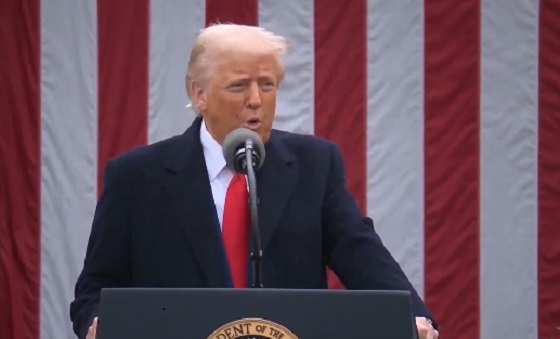Alberta
Turning resources into new jobs and products

(Left to right: Stéphane Germain, president of GHGSat; John Adams, president and CEO, NGIF Capital and NGIF Accelerator and managing partner of Cleantech Ventures; Rebecca Schulz, Minister of Environment and Protected Areas; Scott Volk, director of emissions and innovation, Tourmaline Oil; Justin Riemer, CEO of Emissions Reduction Alberta)
New funding will advance technologies that turn Alberta’s natural resources, such as bitumen, into materials of the future.
Alberta is Canada’s third-largest producer of manufactured goods and materials and first in clean technology innovation. At the same time, manufacturing companies around the world are looking for ways to make products like concrete, plastics, food, wood, chemicals and machinery more efficient, more durable, easier to recycle and better for the environment.
Alberta’s government is investing $40 million from the industry-funded Technology Innovation and Emissions Reduction (TIER) program to advance technologies that will turn everyday items that would otherwise be wasted or dumped in landfills into modern, low-emission products. These technologies will help create jobs, reduce emissions and help Alberta’s manufacturing industry lead the world.
“We have the resources, expertise and entrepreneurs needed to create some of the most advanced materials in the world. This funding competition will help develop new and exciting technologies that reduce emissions, create jobs, reuse waste and keep growing our economy.”
Advanced materials are increasing in global demand. They are new or significantly improved materials that provide a distinct advantage in performance when compared to conventional materials. Advanced materials have already been used to create new construction materials, improved batteries and fuel cells and lighter, stronger aircrafts, bicycles and golf clubs, among other products.
Led by Emissions Reduction Alberta, Alberta’s new funding competition will support scale-up, pilot, and demonstration and first-of-kind commercial technologies that improve the extraction, production, manufacturing, and performance of new and existing materials and products in Alberta. It is open to a wide a range of applicants including researchers, businesses, municipalities and Indigenous communities.
“Enhancing existing products and developing new materials with superior performance while embracing circular economy strategies will help deliver deeper emissions reductions, enhance supply chain resiliency and strengthen industrial competitiveness. This funding, sourced from Alberta’s TIER regulation, is critical and the possibilities are endless.”
The focus of this funding is to help create technologies that turn resources into modern, new products. This includes emerging technologies extracting high value metals like vanadium, titanium and lithium found within natural resources such as bitumen and creating novel, carbon-absorbing materials. These can then be used to improve everything from construction material and consumer electronics to aircrafts and hockey sticks.
“Emerging technology solutions, such as creating advanced carbon products from bitumen, are critical to lowering emissions and creating jobs in the province. Alberta Innovates is pleased to support this call and work closely with Emissions Reduction Alberta to realize a new future for Albertans.”
“By transforming our abundant natural resources into advanced, low-carbon materials, we are not only driving emissions reductions but also creating valuable opportunities for industry growth and export potential. The Government of Alberta’s investment through Emissions Reduction Alberta’s Advanced Materials Challenge demonstrates a commitment to building a resilient economy that harnesses Alberta’s strengths in new and sustainable ways.”
Quick facts
- Applications for the Advanced Materials Challenge close on Wednesday, January 22, 2025, at 5 PM MST.
- Successful applicants are eligible for up to $5 million.
- Applications are open to innovators, technology developers, commercial and industrial building owners, municipalities, Indigenous communities, small and medium-sized businesses, research and development organizations, universities, and not-for-profit organizations.
- Applications are open to emerging technologies. While technology solutions can originate from anywhere globally, they must be piloted, demonstrated or deployed in Alberta.
- The TIER system uses industry dollars to help Alberta facilities find innovative ways to reduce emissions and invest in clean technology to stay competitive and save money.
- Full details on the Advanced Materials Challenge can be found on Emissions Reduction Alberta’s website.
Related information
Alberta
Big win for Alberta and Canada: Statement from Premier Smith

Premier Danielle Smith issued the following statement on the April 2, 2025 U.S. tariff announcement:
“Today was an important win for Canada and Alberta, as it appears the United States has decided to uphold the majority of the free trade agreement (CUSMA) between our two nations. It also appears this will continue to be the case until after the Canadian federal election has concluded and the newly elected Canadian government is able to renegotiate CUSMA with the U.S. administration.
“This is precisely what I have been advocating for from the U.S. administration for months.
“It means that the majority of goods sold into the United States from Canada will have no tariffs applied to them, including zero per cent tariffs on energy, minerals, agricultural products, uranium, seafood, potash and host of other Canadian goods.
“There is still work to be done, of course. Unfortunately, tariffs previously announced by the United States on Canadian automobiles, steel and aluminum have not been removed. The efforts of premiers and the federal government should therefore shift towards removing or significantly reducing these remaining tariffs as we go forward and ensuring affected workers across Canada are generously supported until the situation is resolved.
“I again call on all involved in our national advocacy efforts to focus on diplomacy and persuasion while avoiding unnecessary escalation. Clearly, this strategy has been the most effective to this point.
“As it appears the worst of this tariff dispute is behind us (though there is still work to be done), it is my sincere hope that we, as Canadians, can abandon the disastrous policies that have made Canada vulnerable to and overly dependent on the United States, fast-track national resource corridors, get out of the way of provincial resource development and turn our country into an independent economic juggernaut and energy superpower.”
Alberta
Energy sector will fuel Alberta economy and Canada’s exports for many years to come

From the Fraser Institute
By any measure, Alberta is an energy powerhouse—within Canada, but also on a global scale. In 2023, it produced 85 per cent of Canada’s oil and three-fifths of the country’s natural gas. Most of Canada’s oil reserves are in Alberta, along with a majority of natural gas reserves. Alberta is the beating heart of the Canadian energy economy. And energy, in turn, accounts for one-quarter of Canada’s international exports.
Consider some key facts about the province’s energy landscape, as noted in the Alberta Energy Regulator’s (AER) 2023 annual report. Oil and natural gas production continued to rise (on a volume basis) in 2023, on the heels of steady increases over the preceding half decade. However, the dollar value of Alberta’s oil and gas production fell in 2023, as the surging prices recorded in 2022 following Russia’s invasion of Ukraine retreated. Capital spending in the province’s energy sector reached $30 billion in 2023, making it the leading driver of private-sector investment. And completion of the Trans Mountain pipeline expansion project has opened new offshore export avenues for Canada’s oil industry and should boost Alberta’s energy production and exports going forward.
In a world striving to address climate change, Alberta’s hydrocarbon-heavy energy sector faces challenges. At some point, the world may start to consume less oil and, later, less natural gas (in absolute terms). But such “peak” consumption hasn’t arrived yet, nor does it appear imminent. While the demand for certain refined petroleum products is trending down in some advanced economies, particularly in Europe, we should take a broader global perspective when assessing energy demand and supply trends.
Looking at the worldwide picture, Goldman Sachs’ 2024 global energy forecast predicts that “oil usage will increase through 2034” thanks to strong demand in emerging markets and growing production of petrochemicals that depend on oil as the principal feedstock. Global demand for natural gas (including LNG) will also continue to increase, particularly since natural gas is the least carbon-intensive fossil fuel and more of it is being traded in the form of liquefied natural gas (LNG).
Against this backdrop, there are reasons to be optimistic about the prospects for Alberta’s energy sector, particularly if the federal government dials back some of the economically destructive energy and climate policies adopted by the last government. According to the AER’s “base case” forecast, overall energy output will expand over the next 10 years. Oilsands output is projected to grow modestly; natural gas production will also rise, in part due to greater demand for Alberta’s upstream gas from LNG operators in British Columbia.
The AER’s forecast also points to a positive trajectory for capital spending across the province’s energy sector. The agency sees annual investment rising from almost $30 billion to $40 billion by 2033. Most of this takes place in the oil and gas industry, but “emerging” energy resources and projects aimed at climate mitigation are expected to represent a bigger slice of energy-related capital spending going forward.
Like many other oil and gas producing jurisdictions, Alberta must navigate the bumpy journey to a lower-carbon future. But the world is set to remain dependent on fossil fuels for decades to come. This suggests the energy sector will continue to underpin not only the Alberta economy but also Canada’s export portfolio for the foreseeable future.
-

 2025 Federal Election2 days ago
2025 Federal Election2 days agoMORE OF THE SAME: Mark Carney Admits He Will Not Repeal the Liberal’s Bill C-69 – The ‘No Pipelines’ Bill
-

 2025 Federal Election2 days ago
2025 Federal Election2 days ago‘Coordinated and Alarming’: Allegations of Chinese Voter Suppression in 2021 Race That Flipped Toronto Riding to Liberals and Paul Chiang
-

 2025 Federal Election1 day ago
2025 Federal Election1 day ago‘I’m Cautiously Optimistic’: Doug Ford Strongly Recommends Canada ‘Not To Retaliate’ Against Trump’s Tariffs
-

 Business1 day ago
Business1 day agoCalifornia planning to double film tax credits amid industry decline
-

 Alberta2 days ago
Alberta2 days agoEnergy sector will fuel Alberta economy and Canada’s exports for many years to come
-

 Business1 day ago
Business1 day agoCanada may escape the worst as Trump declares America’s economic independence with Liberation Day tariffs
-

 Alberta1 day ago
Alberta1 day agoBig win for Alberta and Canada: Statement from Premier Smith
-

 2025 Federal Election2 days ago
2025 Federal Election2 days agoDon’t let the Liberals fool you on electric cars






